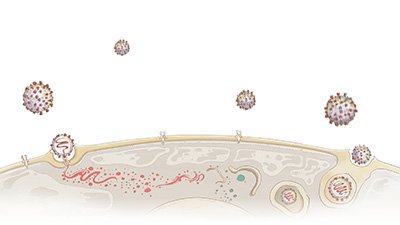Disease
Swine Flu
Typically swine flu does not infect humans but occasionally it mutates and then is capable of infecting humans. Contact with pigs is usually necessary to “catch” swine flu but sometimes it mutates further and is transmissible from human to human.
Cancer
Cancer reminds us of the brokenness, the suffering, and the mortality of creation in this present age, all traceable back to Adam’s sin. Genesis makes it clear that everything in the original creation, was “very good.” We can infer that cancer was not a part of that, since the Bible describes death as an “enemy.”
Bird Flu
It is plain to see that the genetic code of bird flu viruses does not stay the same but is constantly mutating and rearranging. Because virus proteins interact with proteins in the cells they infect, changes in the viral protein can have effects on what type of cells can be infected. So what should one say if asked, “Is the ‘bird flu’ evolving?”
What About Malaria and Other Diseases Before the Fall?
Mosquitoes in the original creation were likely pollinators able to derive the nutrients needed to reproduce from plants without consuming blood. But what about the malaria-causing parasite Plasmodium before “the Fall”?
Disease Topics
Articles About Disease
-
Aug. 20, 2025 from Answers in Depth
Mosquitoes may be annoying pests, but they are also the deadliest creatures in our sin-cursed world.
-
Feb. 28, 2024 from Answers Magazine
When our oldest son was diagnosed with Williams syndrome—a rare genetic disorder that causes cognitive and physical disabilities—my husband and I found ourselves in a whole new world.
-
Aug. 25, 2023 from Answers in Depth
Did God create parasites to make us sick?
-
Aug. 4, 2021 from Answers in Depth
Tick-borne diseases like Lyme disease have plagued humans for millennia. Did God make them that way, and what do they teach us about a fallen creation?
-
July 3, 2021 from Answers in Depth
A creation perspective on why God allows emerging and reemerging diseases like COVID-19 and Lyme Disease that cause emotional, financial, and health problems.
-
Nov. 22, 2017 from Answers in Depth
Understanding the flu’s origins will practically aid us in treating the flu virus, so let’s take a look first at what causes the flu.
-
Semi-Technical In-Depth ArticleThe Design of the Mosquito and Its DangersAug. 11, 2016 from Answers in Depth
If everything that God made was good, where did disease-causing mosquitoes come from? What is the origin of mosquito-borne diseases?
-
July 1, 2016 from Answers Magazine
Zika, spread by mosquitoes, can severely damage unborn babies’ nervous systems and cause them to be born with tiny heads (microcephaly).
-
Evolutionary Conjecture Cannot Cure CancerNov. 27, 2015 from Countering the Culture
Evolutionary scientists assume the patterns they see result from evolution and therefore erroneously believe evolutionary thinking can help the war on cancer.
-
Nov. 22, 2015 from Answers Magazine
Every second, our bodies must monitor a melange of threats that seek to invade and destroy.
-
Semi-Technical In-Depth ArticleSuper Staph in the Community: Is It Evolving?Oct. 22, 2015 from Answers in Depth
Is Community-associated (CA)-MRSA “evolution in action”? Microbiology research based on creation provides some answers to its emerging dominance in the USA.
-
Semi-Technical Book ChapterIs Antibiotic Resistance Proof of Evolution?July 3, 2015 from The Genesis of Germs
Antibiotic resistance is one of the most important topics that a beginning biology student going into medicine should learn and understand.
-
May 14, 2015 from Answers in Depth
Fleas are considered a nuisance. How can they be explained as a part of God’s very good creation?
-
Jan. 24, 2015 from Answers in Depth
Is the war on malaria plagued by “rapid evolution of insecticide resistance” in mosquitoes?
-
Nov. 1, 2014 from Answers in Depth
A physicist and an astrobiologist team up to explain to medical doctors how knowledge of evolution holds the key to curing cancer.
-
Special Report: West Nile Virus—Will It Strike the States Hard Again?July 29, 2013 from News to Know
West Nile virus: brought to you by public enemy number one
-
Cholera Clues Uncovered: Did Cholera Exert “Evolutionary Pressure” on People?July 23, 2013 from News to Know
Evolving people? . . . Or just natural selection in action? Researchers suspect the long presence of cholera has been recorded in the human genome.
-
Malaria in the NewsJune 22, 2013 from News to Know
Can bad-smelling feet, probiotics for mosquitoes, and evolutionary presuppositions solve the problem of malaria?
-
Technical In-Depth ArticleThe Genesis of MalariaJune 19, 2013 from Answers in Depth
Microbiology and parasitology research based on the creation paradigm appears to provide some answers puzzling questions.
-
Parasites Affect Behavior of MothsSept. 17, 2011 from News to Know
Gypsy moth virus packs a weapon of mass dispersion.
-
Grandpa CancerApril 2, 2011 from News to Know
Cancer reminds us of brokenness, suffering, and mortality traceable to Adam’s sin. But evolutionists propose that cancer may be our ancestor!
-
Oct. 25, 2009 from Answers Magazine
Leprosy has terrified humanity since ancient times and was reported as early as 600 BC in India, China, and Egypt. Hansen’s disease is still a major health problem.
-
Magazine Department ArticleFlu AwayOct. 1, 2009 from Answers Magazine
H1N1 flu virus is an example of mutation, not evolution in the usual sense of the word.
-
Swine Flu—Cause for Concern?May 1, 2009
The latest influenza outbreak has people in a panic. What should Christians think?
-
Firefighter Reminds Us of the Influence of the Creation-Evolution DebateJune 21, 2008
An off-hand comment by a firefighter writing in Newsweek reminds us of the immense influence of the creation–evolution debate.
-
Magazine Department ArticleAIDS—No End in SightJan. 1, 2007 from Answers Magazine
Last year marked the 25th anniversary of the discovery of HIV/AIDS. The deadly pandemic virus has been responsible for more than 25 million deaths.
-
Nov. 13, 2006 from Answers Magazine
Governments and industries are attempting to educate the public with a basic understanding of the bird flu virus and precautionary measures to take against it.
-
May 16, 2006 from Answers Magazine
Is the bird flu evolving? The bird flu is changing, but not in the Darwinian sense that it will become something other than an influenza virus.
-
Magazine ArticleThe First Book of Public HygieneDec. 1, 2003, pp. 52–55
The nuns at the Yambuku mission hospital were using five unsterilized needles to give injections to hundreds of people each day. Epidemiologists have concluded that this caused the outbreak.
-
Magazine ArticleRats! Another Case of Sickle Cell AnaemiaMarch 1, 1995, pp. 44–45
As a biology teacher I explain to my higher biology class the so-called 'evidence' for evolution. This often means demonstrating that the evidence is inconclusive.
-
Magazine ArticleSickle-Cell Anaemia Does not Prove Evolution!March 1, 1994, pp. 40–41
Sixth-graders I have lectured on genetic counselling invariably pop some questions such as: ‘Is it true that the sickle-cell phenomenon has established Darwinian evolution as fact?’

Answers in Genesis is an apologetics ministry, dedicated to helping Christians defend their faith and proclaim the good news of Jesus Christ.
- Customer Service 800.778.3390
- Available Monday–Friday | 9 AM–5 PM ET
- © 2025 Answers in Genesis



















